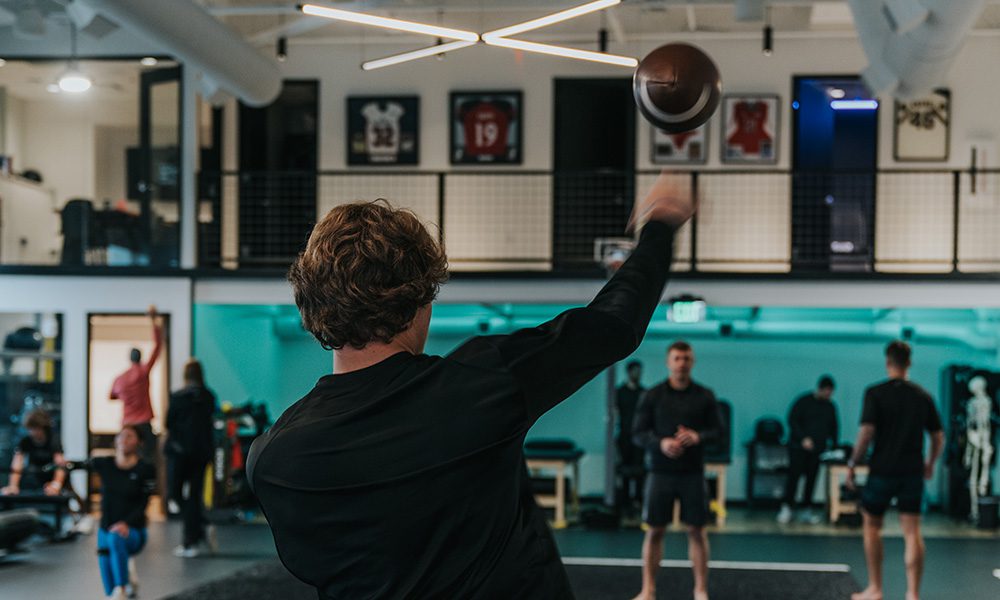For excellent sports performance, athletes need a combination of elite strength, speed, conditioning, plyometric, and movement patterning . Across all sports, specific skills, extensive endurance, and sensible recovery all come into play. Preparing for sports in the preseason, off-season, as well as rehabilitating post-injury are all necessary parts of athletic training. What truly sets high quality athletes apart from others are specific skills like movement variability and explosive power. Efficient movers have the ability to build more power and explosiveness, thereby decreasing the risk for injury. In addition to physical conditioning, learning about the fundamental parts of sports performance and its connection to the brain is so valuable. Read on to learn more about the beginner’s guide to sports performance:
- Footwork is foundational. The feet are crucial for performance in most every sport. The bones, ligaments, and muscles in your feet can serve as springs, levers, pivots, and launching pads for the human body. As the only part of the body that is continuously in contact with the ground, the feet also give sensory feedback and help humans move. Developing strength in the feet is a necessity. Our feet communicate with our brains in order to help with balance and stability. Feet absorb and produce force, making them key parts of producing efficient, powerful movements. Incorporating footwork and building foot strength can help athletes to improve range of motion and overall performance.
- Get to the core. When an athlete’s body is busy moving—throwing, catching, swinging, running, hitting—the core stabilizes the spine. Strong core muscles are central to sports performance. A weak core can cause fatigue, pain, and susceptibility to injuries. On the other hand, a strong core gives athletes the ability to control body position and generate power. Properly training the core requires an athlete to produce trunk stability; this promotes more efficient movement. Ball work using physioballs can help with this. While conventional core work is static in nature, ball work is a dynamic effort to strengthen the core. Ball work focuses on moving the trunk and limbs in functional movement patterns similar to the speed and ranges used in actual athletic performance. In this way, ball work can train athletes for strength in their specific sports. As a bonus, having a strong, stable core can often prevent injuries, boost resiliency, and help with rehabilitation time.
- Specialize in strength. Functional strength training has emerged as being so much more effective than conventional weightlifting. Rather than just lifting weights to get stronger and increase muscle size, it’s important for athletes to focus on specific qualities and exercises that will be most advantageous in their particular sports. Whether you want to swing your golf club like a professional, tackle with NFL-level force, or throw pitches with precision, functional strength training can help you to achieve specific results. Working with equipment like an Accelerated Isokinetic machine allows athletes to have a tailored experience, working with resistance and speed. Keeping specific, improved athletic ability as the end goal can be so much more beneficial than simply building maximal strength.
- Use energy wisely. Plyometrics involves how efficiently the body stores and releases energy, producing powerful movement. The science of jumping, hopping, bounding, and skipping can all be incorporated into a training program for athletes to improve their sports performance. Plyometrics can work wonders compared to conventional strength training; When the brain and body work together, this helps to train tendons and even improve an athlete’s neurological potential. Pushing athletes to focus on maximum force and power truly boosts overall performance.
- Expand your range of motion. Functional range conditioning (FRC) focuses on training athletes’ joints as well as increasing the ability of athletes to control their bodies. FRC isn’t just about the body’s mobility and range of motion, it improves the brain’s control of how the body moves in space. Consider all of the potential joint injuries incurred in sports—knees, shoulders, elbows, hips. Improving your range of motion, strength, and control can help with decreasing injury and preventing pain. By including work with balance, lifting, resistance, speed, and agility, FRC produces positive immediate results as well as long-lasting effects for athletes.
The programs at ROI Physical Therapy and Sports Performance are customized to athletes based on their different goals or needs. ROI Coaches are experts, seeing athletes through tailored progressions of exercise, and they provide athletes with tools to enhance their performance. Become a better athlete with the right training; Learn more or call ROI at 512-962-5141.

